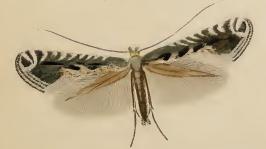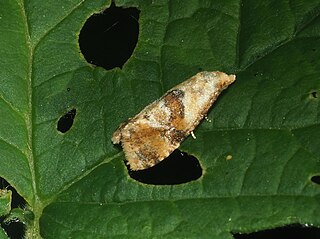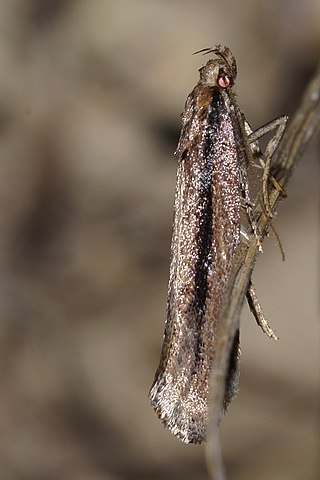
The Cochylini are a tribe of tortrix moths. It used to be classified as the subfamily Cochylinae.

Parornix anglicella is a moth of the family Gracillariidae. It is widespread in: Europe including Albania, Austria, Belarus, Belgium, Bosnia and Herzegovina, Britain, Bulgaria, Croatia, Corsica, Czech Republic, Danish mainland, Estonia, Finland, French mainland, Germany, Hungary, Ireland, Italian mainland, Latvia, Lithuania, Luxembourg, Montenegro, North Macedonia, Norwegian mainland, Poland, Portuguese mainland, Romania, central and northern Russia, Sardinia, Serbia, Sicily, Slovakia, Slovenia, Sweden, Switzerland, Netherlands, Ukraine. Outside Europe it is recorded from the Near East and Nearctic realm.

Ancylis is a genus of moths belonging to the subfamily Olethreutinae of the family Tortricidae.

Acleris is a genus of moths belonging to the subfamily Tortricinae of the family Tortricidae. As of 2007, about 241 species were known.

Phalonidia is a genus of moths belonging to the subfamily Tortricinae of the family Tortricidae.

Sparganothis is a genus of moths belonging to the subfamily Tortricinae of the family Tortricidae.

Parornix torquillella is a moth of the family Gracillariidae found in Europe. The larvae mine the leaves of Prunus species, such as blackthorn. It was described by the German entomologist Philipp Christoph Zeller in 1850, from specimens found in Florence, Leghorn and Pisa.
Aethes rana is a species of moth of the family Tortricidae. It was described by August Busck in 1907. It is found in the United States, where it has been recorded from Illinois, Indiana, Kentucky, Maryland, Ohio and Pennsylvania.
Phalonidia acrota is a species of moth of the family Tortricidae, the subfamily Tortricinae, and the tribe Cochylini. It is found in Peru.
Antaeotricha trichonota is a species of moth of the family Depressariidae. It is found in Brazil and Paraguay.
Antaeotricha phaeosaris is a species of moth of the family Depressariidae. It is found in French Guiana and Guyana.
Antaeotricha nuclearis is a moth in the family Depressariidae. It was described by Edward Meyrick in 1913. It is found in Peru.
Antaeotricha lecithaula is a species of moth in the family Depressariidae. It was described by Edward Meyrick in 1914. It is found in Guyana.
Antaeotricha basilaris is a moth in the family Depressariidae. It was described by August Busck in 1914. It is found in Panama.
Antaeotricha irene is a moth in the family Depressariidae. It was described by William Barnes and August Busck in 1920. It is found in North America, where it has been recorded from Texas.
Stenoma striatella is a moth in the family Depressariidae. It was described by August Busck in 1914. It is found in Panama.

Phalonidia udana, or the loosestrife conch, is a European species of moth of the family Tortricidae, the subfamily Tortricinae, and the tribe Cochylini. It is widely distributed in the North Palaearctic but appears to be largely rare or missing in Central Europe. Previously, it was classified under the Phalonidia manniana taxon, but a recent effort to barcode all North European Lepidoptera revealed that P. udana and P. mannania are two distinct species.

Atomotricha versuta is a moth in the family Oecophoridae first described by Edward Meyrick in 1914. It is endemic to New Zealand and has been observed in both the North and South Islands. The adults of the species are variable in appearance but the three principal variteis are connected b intermediate forms. The female of the species is brachypterous and is incapable of flight. Both the adult male and female have been observed resting on fences during cold winter nights.










